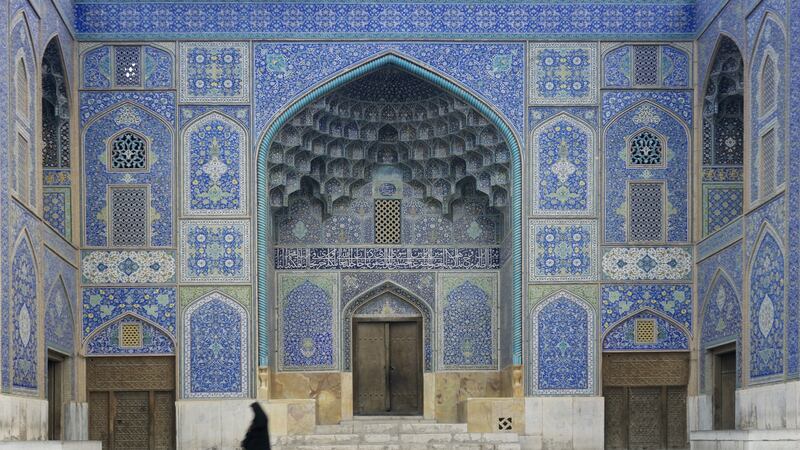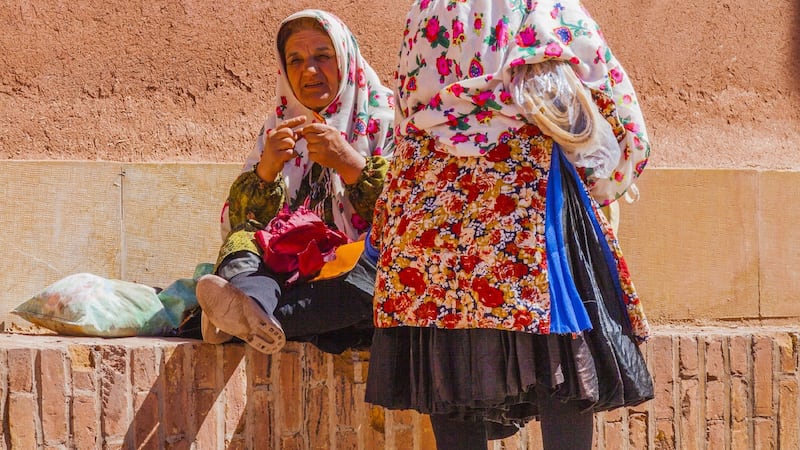On February 26th, as Irish people voted in the general election, 60 per cent of Iranians also voted. The result was a momentous loss of seats for hardliners who had vehemently fought president Hassan Rouhani’s attempts to open the country to valuable external investment and much-needed liberalisation.
Early the following Monday morning, we arrived in downtown Tehran to a city silent with sleep and apathy. In a capital with a population of more than 12 million, this deathly silence was indicative of a country in limbo – and socially imprisoned.
Ours was not a straightforward trip: this was an observational journey through a barren tourist landscape. We were happy to have arrived and subsequently break through both bureaucratic constraints and our preconceptions.


Our eight-day journey begins as Ali Taheri, our kind and essential guide/ minder, picks us up in his air-conditioned Peugeot and whisks us off to look at the propagandist anti-American murals around the US embassy and other locations. This was preimagined Iran at its visual best. Women in full black chadors punctuate this landscape. We are fully in Iran now, and in another world. Yet the feeling on the ground is safe and people are universally welcoming.
It is then on to the Azadi monument, resplendent in white marble, for some sunset shots. The Azadi has been a symbol of Tehran since it was finished in 1971.
These touristy activities are made weightier by the lack of a tourist industry here. Postcards haven’t been printed since the 1970s, and everyone asks how we find Iran. We answer that we love Iran. But it’s the people we really love and we want them to know that.
We then take a blue-skied road trip to Kashan, about 250km south of the capital. I love these long stretches of road: Ali telling us stories and us getting lost in our thoughts watching the locals herding goats and the bright Iranian advertisements in Farsi on the roadsides. Every sight was a perfect photograph waiting to be taken.
Close to sundown we arrive in Kashan, and it is immediately more peaceful. We check into the historic Manouchehri House (manouchehrihouse.com) in the residential area of the city. Owned by an Iranian businesswoman who lives in Switzerland, this stunningly restored property shows a respect of Persian history, architecture and craftsmanship.
Manouchehri Houses stands as a singular event of cultural integrity: due to the constant cycle of demolishing and rebuilding, very little old architecture remains. Stained-glass windows, Venetian-style multicoloured chandeliers, wood panelling and restrained luxury are hallmarks of a place that cares deeply about its rich history.
The food is also the best we have had on the trip. Breakfast's highlight is the preserved fruits so typical here – local feta, flat breads and, believe it or not, porridge with meat. Lunch consists of sour chicken with walnut and pomegranate, shefteh/kooftah somagh (a veal meatball with sumac), torshi (a date and mixed pickle) and eggplant yogurt, all washed down with a mint kefir yogurt drink that is hard to stomach initially, but is a really healthy option. There is no alcohol at all, so we drink the malty non-alcoholic beers and, to finish, cherry tea on the terrace.
Kashan is famed for its merchant houses, decommissioned hammams (bathhouses) and caravanserais – the large, open- plan buildings for camels to gather and goods to be shared on the old silk routes. Collectively, this suggests a rich and varied history, but most of these buildings are ruins and the exotic exchanges of the past are a distant memory.
We are excited to check out the main bazaar, but found it to be a "made in China event", similar to Tehran and a nod more in the direction of Russia than to the rich bazaars of Istanbul and Marrakesh. It leaves us longing to find some old Persian objects that would offer a precious connection with the past.
On the road again, we pass a nuclear installation in Natanz, as you do. We then make our way to Abyaneh, a small village at an altitude of 2,500m that dates back to the 13th century. Abyaneh is a joyful architectural celebration of mud-coloured buildings, filled with small alleys and women wearing traditional matching floral chadors.
Everyone we meet seems to be over the age of 80; the local activity of picking fruit seems blissfully beyond them as they idle along gossiping in the sun. Rickety old shops sell traditional wear and we stop for cardamom tea and the freshest dates in the town’s only hotel.
The call to prayer sounds as we walk to the top of the nearby mountain for a panoramic view in the crisp mountain air – a resounding highlight for all of us in this picturesque hidden hamlet.
Esfahan is, to use a loaded term, the jewel in the crown, and it retains that rich Persian culture we have been hoping for. It brims with historic monuments, including mosques so extensive and exquisite that you are left quite overawed. Those moments watching people in prayer as the sun fills in the long windows is an image of Iran I had brought with me, and it was fully realised here.
A long journey by road back follows. We reflect on the trip, such as the immense kindness of the people pushing flowers in the windows of our car. Iranians believe that a guest is a friend of God.
We think also about the repression of the past few days. The need to cover completely affected me, not so much in the symbolic way but more in the physicality of it, the difficulty in moving around. But my discomfort is only temporary, and I am aware that Iranians have weighty restrictions that last lifetimes.
As we come to the end of our road trip, we notice that we have been listening to Iranian classical music mixed with western pop songs. We wonder: is it on the radio? Then Tom Jones comes on, and we know it is definitely a tape.
I ask a beaming Ali if he is happy. He says if we are happy, he is happy. It is a perfect last moment.
The graciousness of this amazing Iranian man, his utter goodness like all his people is coupled with the happiness we feel to re-embrace the freedom of our own culture in that moment, having lost it for our time here.
This was a trip of a lifetime, but more for what wasn’t there than what was. We exist in freedom, and visiting Iran makes me realise this more than ever and to really appreciate that.
I hope that Iranians find a similar freedom; people this pure and good deserve a future with hope and possibility.
GET THERE
Turkish Airlines flies from Dublin to Tehran via Istanbul. Aoibheann’s flights cost approximately €550.
STAY
Hotel Atlas in central Tehran is a good base to start from. Double rooms from approx €100 per night (atlas-hotel.com).
Manouchehri House in Kashan is a beautifully restored Persian residence with eight rooms, from approx €70 a night for two sharing. Breakfast included.
(manouchehrihouse.com)
THINGS TO KNOW
Visas: A tourist visa is essential. You can apply through the Iranian embassy in Dublin (embassydublin.com/iranian).
Before you go and getting around: There is no online access to
accommodation booking – so you’ll need to book by email. This can take some time. A guide from the moment you arrive is essential. Our experience would have been completely different without a local to look after everything. We heartily recommend our man in Iran, Ali Tehri at iran-tehrantourist.com.
Price depends on the size of the group, but we paid approximately €100 a day.
Money: You cannot use your credit card, so bring the cash you need and change it there. Money is in huge multiples and very confusing.
Clothing: Women must cover their head and body at all times with a scarf over the head and loose fitting tunics over long-sleeved tops and trousers. Any lapses and Iranian mystery men will approach your guide and instruct same. Men should wear long-sleeved shirts and long trousers.
Phone and internet: Your phone network and Facebook won’t work, but Instagram does and email access is fine.
Popular culture: There are no international chains such as McDonald’s or Starbucks, and no alcohol. There is no overt nightlife; smoking in public is rare.
EAT
Eating out is incredibly cheap (a good coffee is less than a euro). Masoudieh Cafe is in one of the oldest palaces of the same name, an elegant and old-world space with red and blue stained-glass windows.
We enjoyed barley vegetable soup and kashko badenjan (eggplant, fried onion, whey and mint). The drinks were a sensation – rose petal cold infusions and cinnamon mint tea.
You’ll find fresh pomegranate juice – so refreshing – firni rice pudding with grape syrups, and apple turnovers at all shop stalls. Try the ubiquitous avashyak, wet dried fruits.
The food we had dining out was not amazing: the real gold happens in homes, so try to secure an invitation. Most Iranians would be overjoyed to have you.











